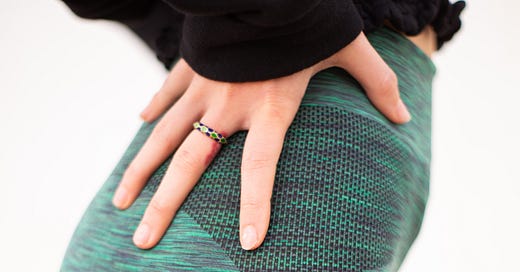Case study
I am a 39-year-old male with multiple sclerosis who was treated with interferon-beta before having two courses of alemtuzumab. It was about three months after the second course that I developed right hip pain and, two months after that, left hip pain. After an MRI of my hips, my orthopaedic surgeon diagnosed me with bilateral avascular necrosis (AVN) of the hip. Apparently, the high-dose steroids I was given to prevent alemtuzumab-related infusion reactions are responsible. As it has been many months since developing AVN, I will now have to have bilateral hip replacements. I was never told about AVN being a possible complication of high-dose steroids. Should I have? I am told that if AVN in my right hip had been diagnosed earlier, I could have prevented it from happening in the left hip. If I had been told what to look out for, I could have saved at least one of my hips.

Prof G’s opinion
Your experience is typical. I did a bone health survey on the MS Blog several years ago, and over 75% of respondents stated they had not been told about AVN being a complication of high-dose steroids. The problem is that neurological consultations are so short that it is difficult to discuss everything in the allocated time. One of the things that frequently gets overlooked is bone health, including uncommon side effects of high-dose steroids, such as AVN, osteopaenia and osteoporosis, psychosis, etc.
How common is AVN in pwMS on high-dose steroids?
There is not enough data to say how common AVN is in pwMS and at what dose of steroids or after what number of courses of steroids the risk of AVN increases. Below is small case series of five patients with MS and AVN. The worrying thing is that all of these patients had a delayed diagnosis, which is why this Newsletter is so essential reading.
I recall a case I looked after who developed bilateral AVN of the hips after only one course of high-dose methylprednisolone for a severe spinal cord relapse. Similarly, the patient above developed AVN after only two courses of steroids to prevent alemtuzumab-associated infusion reactions. These cases illustrate to me that AVN can occur after just one course.
In addition to steroids, other risk factors that may or may not be relevant to MS include smoking, excess alcohol consumption, trauma, sickle cell disease, certain types of cancer, such as leukaemia, decompression sickness, Gaucher’s disease, gout, HIV infection, pancreatitis, rheumatoid arthritis, lupus, radiation therapy, chemotherapy, and organ transplantation (particularly kidney transplantation).
In the early stages of AVN, pwMS may not have any symptoms. As the disease progresses, however, most experience joint pain. At first, the pain occurs only when putting weight on the affected joint. Later, it occurs even at rest. The pain usually develops gradually and may be mild or severe. If AVN progresses and the bone and surrounding joint surface collapse, pain may grow or increase dramatically. Pain may be severe enough to limit the range of motion in the affected joint. The period between the first symptoms and loss of joint function is different for each person, but it typically ranges from months to years.
AVN is usually diagnosed on history and examination, followed by imaging. This is why well-localised hip pain should be taken very seriously. The latter may include a plain hip x-ray, but a plain x-ray is typically normal early on. MRI or a CT is generally diagnostic, and a bone scan helps in that it identifies other joints that are involved that are asymptomatic.
I suggest reading the NIH health information sheet for more information on AVN. The treatment of AVN is symptomatic, but if the AVN is unilateral, a core decompression of the opposite hip may prevent it from becoming bilateral. However, not all orthopaedic surgeons agree with prophylactic decompression. It seems as if the evidence base regarding the latter is not black-and-white but shades of grey, not too dissimilar to the field of MS.
I am interested to hear if you have been told about AVN and what to look out for to self-diagnose the possibility of having AVN before starting a course of high-dose steroids. Have any of you had AVN of the hip? If yes, please share your experiences with us. Please note although the hip is the commonest site for AVN, other long bones can rarely be affected. You may have also heard bisphosphonate treatment for osteopaenia is associated with AVN of the jaw. This is a very different type of AVN compared to AVN of the hip and other long bones. There is some evidence that bisphosphonates may help treat AVN of the hip.
Osteonecrosis of the femoral head is a severe complication of corticosteroids, which may lead to more disability in multiple sclerosis (MS) patients because of delayed diagnosis. The exact dose and risk period of steroids which cause the necrosis are not clearly known. The aim of the study was to enhance the attention of clinicians to leg pain in MS patients with regard to steroid therapies. We report five MS patients with femoral head necrosis who had relapsing-remitting MS and received different doses of methylprednisolone. Our young cases consist of three females and two males. The duration of disease varied between 1 and 3 years. The least interval between the last pulse of prednisolone and diagnosis of avascular necrosis was 6 months. Two of them received one pulse of 5 g of methyl prednisolone. All five patients had delayed diagnosis because the signs and symptoms were attributed to MS, which indicate the necessity of further focusing attention to early evaluations.
Subscriptions and donations
Paid subscriptions to MS-Selfie are being used to administer the Newsletter and associated MS-Selfie microsite currently in development. At the request of several readers, I have now added the option of making a one-off donation. To keep this initiative open to all readers, I would appreciate it if those who can afford a subscription please subscribe. For active paying subscribers, thank you; your contribution is much appreciated.
Links
General Disclaimer
Please note that the opinions expressed here are those of Professor Giovannoni and do not necessarily reflect the positions of Barts and The London School of Medicine and Dentistry, nor Barts Health NHS Trust. The advice is intended as general and should not be interpreted as personal clinical advice. If you have problems, please tell your healthcare professional, who will be able to help you.














Share this post